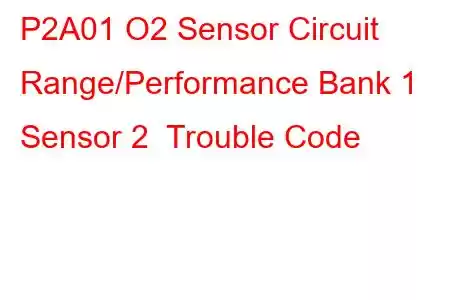Home » P2800-P2C99 Codes » P2A01 P2A01 O2 Sensor Circuit Range/Performance Bank 1 Sensor 2
OBD-II Trouble Code Technical Description
O2 Sensor Circuit Range/Performance Bank 1 Sensor 2
What does that mean?
This diagnostic trouble code (DTC) is a generic powertrain code, which means that it applies to all 1996-newer vehicles (Dodge, Ford, Chevy, Kia, Ram, Honda, Pontiac, etc.). Although generic, the specific repair steps may vary depending on make/model.
In my experience, when an OBD-II equipped vehicle has stored a P2A01 code, it means that the powertrain control module (PCM) has detected a malfunction in the downstream (or post catalytic converter) oxygen (O2) sensor or circuit. Bank 1 denotes the bank of the engine that contains the number one cylinder and Sensor 2 indicates that the malfunction is related to the downstream sensor.
O2 sensors are made with a zirconium dioxide sensing element protected by a vented steel housing. The sensing element is attached to wire leads in the O2 sensor wiring harness using platinum electrodes. A controller area network (CAN) connects the PCM to the O2 sensor wiring harness. The O2 sensor provides the PCM with data regarding the percentage of oxygen particles in the engine exhaust as compared to the oxygen content of ambient air.
Exhaust gases escape the engine into the exhaust pipe and through the catalytic converter; then pass over the downstream O2 sensor. As exhaust flows through the vent holes in the steel housing and across the sensing element, ambient air is drawn through the wire lead cavities and into a small chamber in the center of the sensor. In the chamber, the ambient air is heated by the exhaust, forcing the oxygen ions to produce (energy) voltage. Variations between the number of oxygen molecules in ambient air (drawn into the O2 sensor) and the concentration of oxygen ions in the spent exhaust gases cause voltage levels to change.
A typical oxygen O2 sensor:
These changes cause the oxygen ions inside the O2 sensor to bounce between platinum layers very rapidly and repetitiously. Voltage variations occur as the rushing oxygen ions bounce between platinum layers. The PCM recognizes these variations in voltage as changes in exhaust oxygen concentration. These changes indicate whether the engine is either running lean (too little fuel) or rich (too much fuel). The voltage signal from the O2 sensor is lower when more oxygen is present in the exhaust (lean condition) and higher when less oxygen is present in the exhaust (rich condition). This data is used by the PCM to calculate fuel delivery and ignition timing strategy. The upstream O2 sensor reacts with a lot of fluctuation normally, whereas the downstream should be more steady, if things are operating normally.
If the downstream O2 sensor circuit fails to respond as expected, over a set period of time and under certain programmed circumstances, a P2A01 code will be stored and a malfunction indicator lamp may be illuminated.
Severity & Symptoms
Since a P2A01 code means that the downstream O2 sensor has failed to input an acceptable signal to the PCM, it should be considered severe.
Symptoms of a P2A01 code may include:
Diminished fuel efficiency A lack of general engine performance Other related diagnostic trouble codes may also be stored Service engine soon lamp illuminationCauses
Possible causes for this engine code include:
A failed O2 sensor Burnt, broken, or disconnected wiring and/or connectors Engine misfires Vacuum leaks Bad mass air flow or manifold absolute pressure sensor Engine exhaust leaksDiagnostic and Repair Procedures
A good starting point is always to check for technical service bulletins (TSB) for your particular vehicle. Your issue may be a known issue with a known fix put out by the manufacturer and can save you ti
Read: 24


